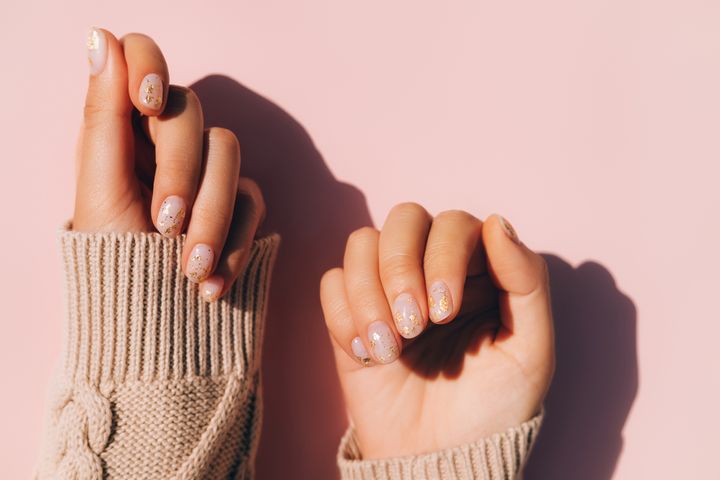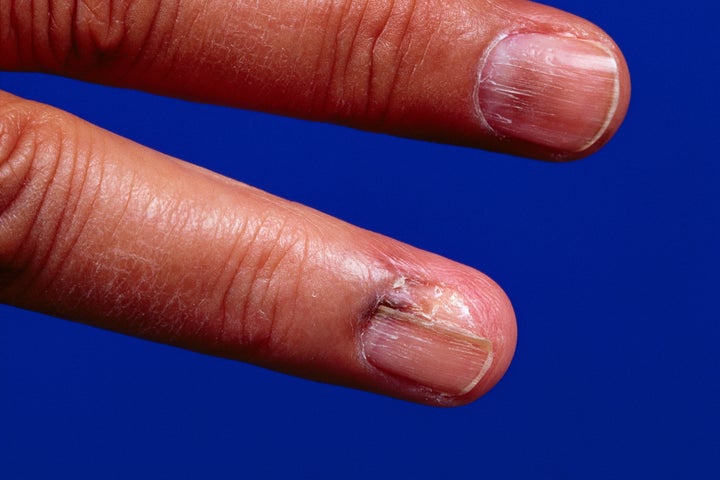
Did you know that your nails can reveal a lot about your health? Visual cues from your nails may be able to signal vitamin deficiencies or illness — and, in serious cases, even melanoma or heart issues.
Nail technicians aren’t able to diagnose conditions, but they can help you spot changes in your nails.
“We are primarily focused on nail care, so if we notice something unusual, we might suggest that the client consult a health care professional for proper evaluation,” said Silva Nahabedian, a director of education at Dazzle Dry. “Health concerns should always be addressed by a qualified medical expert,” she added.
“When your body is sick internally, [sometimes] your nails are the first to show signs,” said Marcela Correa, a licensed medical pedicurist who owns Medi Pedi NYC.
We asked nail experts what they might notice while doing someone’s manicure or pedicure. These signs don’t always mean there’s a serious underlying issue, but it’s important to know when to see a doctor.
Here’s what nail techs have witnessed firsthand
Dr. Dana Stern, a board-certified dermatologist, said that dry, callused or cracked feet can be a sign of diabetes, as people with diabetes are more prone to neuropathy, which causes nerve damage.
“A client of mine had unusually thick calluses on her soles,” said Jin Soon Choi, the founder of the New York salon Jinsoon. “I used blades to remove them (this was permissible back then), and I strongly advised her to consult a doctor. She was diagnosed with diabetes.”
According to the American Diabetes Association, “nerve damage can also lead to changes in the shape of your feet and toes,” particularly dry feet that can peel and crack. This dry skin may build up and lead to calluses if not checked often.
Another issue the experts have come across is skin cancer. Both Correa and Nahabedian have strongly advised clients to see a medical professional after noticing a brown-black discolouration on the nail bed. In these cases, the clients were diagnosed with subungual melanoma, a rare type of skin cancer — which, thanks to their nail techs, was caught early.
Stern explained that a dark line on the nail may also be due to trauma. So, this is not always a cause for concern, but it’s still important to check with a doctor. Pigmented bands on the nails are more common in people with darker complexions, who have more melanocytes in their skin.
“Multiple pigmented bands are usually nonworrisome. When stimulated, the melanocytes begin to produce pigment, appearing as a brown, lengthwise band in the nail. Trauma to the matrix region is a definite stimulator,” Stern said.
“Melanoma is the most concerning sign that a nail tech should be aware of,” she said. “They can potentially save a life if they are astute and have someone competent to refer to. I would suggest that they send concerning nail signs to a board-certified dermatologist in their area.”

More signs to be on the lookout for
Stern has verified that all of the below are signs that aren’t necessarily indicative of a health problem, but could potentially be something to keep an eye on.
Changes in shape
Curved or clubbed nails: These are wider and have a rounded nail tip. Stern said that acquired clubbing — which has its onset later in life, not at birth — is often due to an internal health issue and may signify lung or heart problems.
Spoon nails (koilonychia): These are concave, as though the shape can hold water. This can be a sign of an abnormality in iron metabolism.
Terry’s nails: Two-thirds of the nail will appear white and the tip will be pink. This can be indicative of cirrhosis, congestive heart failure or diabetes mellitus.
Half-and-half nails: Half of the nail (closest to the cuticle) will be white and the distal part will be pink. Stern said this is also referred to as “Lindsay’s nails” and can indicate kidney failure.
Thickened nails: Thickened, discoloured or crumbling nails may be a sign of fungal infections, psoriasis or circulation problems. The issue could also be due to repetitive microtrauma and aging.
Ingrown toenails: These can cause redness, swelling and discomfort, and they may be observed during a pedicure. They can lead to infection, and caution should be taken when treating ingrown toenails in a salon.
Corns or calluses: Thickened areas of skin on the soles of the feet (or toe web spaces and toes) could be a sign of excessive pressure or friction, and may need attention.
Textural changes
Nail peeling and longitudinal ridging (onychoschizia and onychorrhexis, respectively): These can lead to nail splits or breaks, and are often due to nail dryness and excessive use of nail products. Causes may include certain medical conditions like hypothyroidism (underactive thyroid), anaemia, Raynaud’s disease and protein deficiency. If you have eczema, you may notice nail peeling or surface irregularity due to the skin inflammation associated with the condition.
Brittle nails: This issue can be due to aging, genetics, water and chemical exposure, damage from nail cosmetics, or certain medical issues (like anaemia or fungal infections).
Pitting: Tiny depressions or dents may indicate conditions like psoriatic arthritis. The issue is also connected to psoriasis, with symptoms like nail separation (onycholysis).
Ridges: While vertical ridges are often an aspect of aging, horizontal ridges (Beau’s lines) may point to systemic illness, fever or trauma. They can also be due to aggressive cuticle manipulation or pushing back at the cuticle repetitively (habit-tic).
Changes in colour
Nails change colour for a variety of reasons. Some are purely aesthetic, and others may be more serious.
“It’s important to note that changes in nail colour are not always indicative of health problems,” Nahabedian said. “Many factors, including genetics, aging and nail care practices (like nail polish or acrylic nails), can affect the color of your nails.”
Stern said the following colours and condition could potentially be linked to certain health issues, in some cases.
Pale or white nails: These can be a sign of anaemia, liver disease, malnutrition or poor circulation. They can also occur due to aging. If your nails are persistently pale, it’s a good idea to consult a health care professional.
Yellow: This can be a sign of a fungal infection (onychomycosis) or migration of the dyes within the pigment of nail polish. Some people have more porous nails and are more prone. In some cases, This can be associated with more serious conditions like psoriasis, and respiratory conditions.
Yellow/green: When the nail appears thick and yellow/green, it could be yellow nail syndrome. It frequently lacks a cuticle as well as a lunula (the half-moon that is usually visible on the thumbnail and great toenail). This is due to the failure of the nail to grow sufficiently and is associated with lymphatic disease, as well as lung disease or malignancy.
Mees’ lines: If you see white stripes that follow the contour of the moon, this could indicate arsenic exposure, among other things.
Red-spotted lunula: Red dots in the moon of the nail could point to a variety of conditions.
White spots (leukonychia): These can be a sign of a fungal infection, or trauma. They are often caused by minor trauma, but large or numerous spots might signal a fungal infection or other medical issues. But there are many causes for white spots, not all of which are worrying. When a white spot is small, it is usually punctate leukonychia and is most commonly due to trauma to the nail matrix.
Green nails: These can be caused by bacterial or fungal infections. Pseudomonas bacteria are often responsible.
Black/dark brown streaks: Dark streaks or bands on the nails may be due to trauma, but they can also be a sign of melanoma. If you notice sudden or unexplained dark streaks, it’s important to seek medical attention promptly.
Red or brown streaks: These may be a sign of splinter haemorrhages, which can be associated with various conditions, including endocarditis (a heart valve infection). It will look like you have a splinter in your nail. But most commonly the issue is due to trauma to the nail.
Blue: This may indicate poor oxygenation of the blood (cyanosis), which can be a sign of respiratory or circulatory problems. It can also be due to the intake of colloidal silver (systemic argyria).
Purple or dark blue: This can be a sign of poor oxygenation, suggesting heart or lung problems or Raynaud’s disease. It can also result from exposure to cold temperatures.
Discolouration: This is often the result of dehydration caused by the chemicals in acrylic nails, giving them a yellowish and thin appearance, or pigment migration from regular nail polish. To prevent future yellowing, regular at-home exfoliation and hydration are essential. People who love polish should avoid leaving it on for more than two weeks. If green, the issue can be due to trapped water and moisture beneath the nail, leading to bacterial growth, which needs to be treated by a physician. Discolouration may also indicate the initial stages of nail fungus, which, if left untreated, can lead to complete nail loss.
Overall, nail changes are not always cause for concern. Certainly, having a go-to nail technician who has been properly educated on the importance of nail health — and its connection to various conditions — is very important. When in doubt, visit a health professional for further evaluation, and keep an eye out for any sudden changes.